The NeuroGym® Trainer is a mobile, multi-faceted biofeedback device designed to help clients regain motor control and coordination. It uses input from various sensors to control the action of computer games.
Targeted muscle activity and movements can be encouraged or discouraged by simple adjustments to software parameters. The NeuroGym® Trainer provides real-time, speed sensitive feedback, allowing highly intensive goal-oriented and motivational rehabilitation.
Unlike traditional biofeedback devices, the NeuroGym® Trainer provides exceptional versatility through the use of various input sensors that monitor muscle activity (EMG), weight shift or pressure changes, tilt, and proximity to a target. A therapist may choose to use a sensor individually or in combination with others. In addition, therapists can choose from a number of programs to design treatment plans ranging from simple one-channel programs to multi-channel training set-ups. This versatility allows therapists to target individual muscles for relaxation or activation or to train more complex multi-joint movements.
The unit comes standard with computer, software, 4-channel interface box, 2 pressure sensors and a carrying case.
Features
- Goal-oriented, motivational training software emphasizes
both movement accuracy and speed sensitivity - Monitor displays the game and oscilloscope simultaneously
- Multiple sensors are available, including EMG, pressure, tilt,
stretch, proximity, joint angle alarm goniometer, and incontinence
vaginal probe - EMG sensors can detect even minimal muscle activity
- Game and oscilloscope settings can be stored for use in
multiple training sessions and to record patient progress

Sensor Descriptions
- Pressure Sensor
- Proximity Sensor
- Tilt Sensor
- Stretch (Belt) Sensor
- Fine Pressure Sensor
- Finger Movement Sensor
- Instrumented Ankle Trainer
- Alarm Goniometer
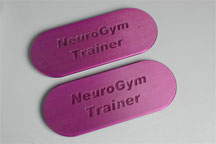
Pressure Sensor
Pressure sensor for training weight shift, balance and mobility. The NeuroGym® Pressure Sensors are two separate foot-sized solid sensors that depict relative pressure and can be used in a variety of effective ways to provide the environment for balance and stability training. The sensors may be stood upon, sat upon, stepped upon or jumped upon to create ever-expanding performance demands.
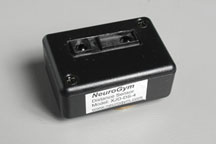
Proximity Sensor
A Magnetized sensor that detects distance. This infra red sensor presents a very practical way to monitor body parts moving toward each other or toward a static object.
It can be attached to the training individual’s body or reflect the distance of the individual from a designated target.
It may even be attached to a mobile system reflecting the outcome of the individual’s effort – for example to a weight-training machine effected by the individual.

Tilt Sensor
A Magnetized sensor that detects changes in vertical orientation. Most human movements involve body parts in the process of changing their vertical orientation.
The NeuroGym® Tilt Sensor provides an effective way to monitor elbow or shoulder movements, knee or hip bend, trunk mobility etc. Similar to the Proximity Sensor, it may also be mounted on a moving arm of a machine effected by the training individual.
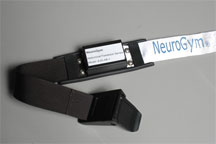
Stretch (Belt) Sensor
Belt mounted sensor that measures stretch. Significant activity of muscles and joints can be monitored with this smart sensor designed to display the degree of inflation/deflation of body parts underlying it.
For example, the sensor can accurately relay information on chest inflation/deflation, abdominal cavity deflation or on the activation of the biceps brachi.
It may be therefore used to enhance function in muscles otherwise difficult to monitor effectively such as the transversus abdominus of the diaphragm muscles.

Fine Pressure Sensor
Pressure sensor for training fine motor control. As is the case with the bigger pressure sensors used for training of the lower extremities, the NeuroGym® Fine Pressure Sensor provides an effective and variable training environment that may be used to improve finger and hand pressure, pinch or speed of motion.
The NeuroGym® Trainer software, combined with fine pressure sensors provides an effective way to work on improving control and coordination of the hand.
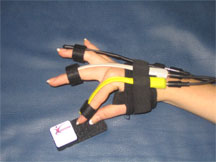
Finger Movement Sensor
The NeuroGym® Finger Movement Sensor enables intensive training of the fingers with the NeuroGym® Trainer.
The sensors are malleable straps that attach to the fingers and detect flexion/extension along the metacarpal-phalangeal and inter phalangeal joints. A number of finger sensors can be attached simultaneously to the user’s hand with a glove-like harness.
Using the NeuroGym® Trainer software, these sensors could assist in intensive training of the fingers to improve their active range and coordination. Moreover, it could also be used to encourage specific finger movements and discourage others in a single training paradigm as well as to create an upper extremity synergy of preferred hand, elbow and shoulder movements.
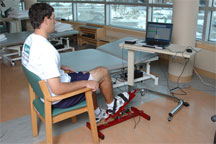
Instrumented Ankle Trainer
The NeuroGym® Ankle Trainer (designed to train ankle strength and control in all directions) while a stand-alone tool that can be used with a pulley to provide effective progressive resistance training to the ankle, may also be instrumented with 2 potentiometers that sense ankle motion in 2 planes of action.
This option provides a quick and practical way to train the neurologic or orthopedic ankle with the sophistication and gradation of movement provided by the NeuroGym® Trainer software.
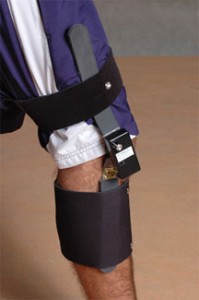
Alarm Goniometer
Joint goniometer with an option of pre-set joint ranges. The NeuroGym® Alarm Goniometer is an effective tool to train joint motion and joint desired position. It is a stand alone training tool that provides auditory feedback on deviating/achieving a predetermined joint angle.
It could therefore be used to discourage hyperextension of the knee in walking or the typical flexed position of a paretic elbow. It is also designed to interface with the NeuroGym® Trainer, thus allowing for an intensive speed-sensitive training of joint movements.
